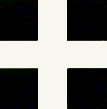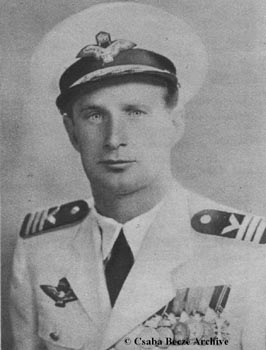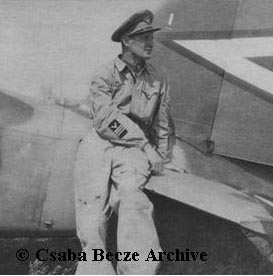Hungary

Százados László ‘Lacika’ Tomor
Hungary

Százados László ‘Lacika’ Tomor

László Tomor was born in Tiszolc (today Tisovec, Slovakia) on 30 July 1909.
Tomor graduated from the Ludovika military Academy with the rank of hadnagy (2nd Lieutenant) on 20 August 1931.
After his graduation he served at Székesfehérvár-Sóstó and Szombathely airfields in different assignments.
He was promoted to főhadnagy on 1 November 1934.
He was transferred to the 1/3. "Kőr Ász" vadászszázad in the late summer of 1938 and took over command of the squadron in the autumn of 1939.
On 1 September 1940, he was promoted to százados.
He was still Commanding Officer of the 1/3. "Kőr ász" vadászszázad at the time of the assault on Soviet Union. The unit was at the time equipped with Fiat CR.42s.
On 12 July, twelve CR.42s of the 1/3. "Kőr ász" vadászszázad, under the command of százados Tomor, redeployed to Kolomea (Kolomiya), and were immediately engaged in combat operations.
On 22 July, százados Tomor, squadron CO of the 1/3. vadászszázad took of from Bar airfield with four other CR.42s to reconnoitre the area between Braclav, Bersady, Tulchyn and Dzhurin. During this mission, they attacked and strafed enemy columns and armour. Ground fire was intense and only one Fiat escaped unscathed, because the aircraft lacked armour protection and thus were vulnerable to ground fire. Százados Tomor was wounded in five different places, and received the most punishment; nevertheless, he returned to base.
On 5 August 1941, it was reported to the Hungarian headquarters that a multi-engined Soviet aircraft had landed in the village of Podvysokoye, possibly with the order to rescue some high-ranking officers or commissars of the surrounded Soviet army in the Uman pocket. Six CR.42s of the 1/3. vadászszázad took off and százados Tomor lead the first section, while hadnagy János ‘Hanzi’ Pettendi led the second. Another pilot who took part in this mission was szakaszvezetö Lajos Göcsei. They circled around the village at 6000 feet, but they couldn’t locate the target. Tomor spotted a building, which looked like a command post; thus, he decided to investigate. He dived steeply, followed by the others. The antiaircraft batteries remained silent, reluctant to disclose their location too soon. As his Fiat zoomed downward, Tomor suddenly sighted a well-camouflaged three-engined machine standing next to a house at the village’s perimeter. A few jerks on the stick, slight adjustments, then he pressed the firing button. Now the defences opened up. However, it was too late. The tracers found their mark and the big transport went up in flames. All the Hungarian CR.42s sent at least one long burst into the burning aircraft. However, the antiaircraft fire was heavy and every one of the fighters received hits and only two being able to return to base. Two pilots were missing but luckily Göcsei soon rang and reported that his aileron cable had been damaged and he had made an emergency landing at Anapol (80km west of Rovno). However, there was no news from Pettendi, a famous sporting airman. Despite the ensuing aerial search and inquiries made through intelligence channels, no trace of him was ever found thus making him the squadrons first and only pilot killed in combat during this tour of duty.
At 04:30 on 11 August, a record number of five out of the six Caproni Ca.135bis took off and performed a successful bombing raid on Nikolayev. They also attacked a strategic bridge over the Bug River close to the city. The bombers were joined by their unusually strong fighter escort – comprising six CR.42s of the 1/3. vadászszázad and five Re.2000s of the 1/2. vadászszázad led by százados Tomor – over Pervomaysk airfield. Loaded with captured Soviet 100kg bombs, the Capronis flew out over the Black Sea east of Odessa before making a wide circle to surprise the city’s defence by coming from the south-east. The leading aircraft, with flight leader föhadnagy István Szakonyi at the controls, released its bomb load on the central railway station from 3000m. The other bomber raj (flight) bombed the bridge.
The Hungarian encountered strong anti-aircraft fire. The starboard engine of B.517, the aircraft flown by föhadnagy Szakonyi, was hit by shrapnel, causing the aircraft to lose speed and lag behind the rest of the formation. The lone Caproni was then attacked by six I-16s but despite repeated attacks from various angles, the fighters couldn’t score a fatal hit. Moreover, the bomber’s two gunners claimed three of the attackers. Örmester János Bánkuti (radio operator) reported shooting down two and szakaszvezetö János Mester (flight engineer) one. One of the I-16s had positioned itself in the bomber’s blind spot as it closed in from behind for the kill but was jumped at the last minute by a CR.42, who promptly shot it down. Soon after this episode, the bomber reached friendly territory but because of the extensive damage sustained during the combat, the pilot decided to land at the larger Pervomaysk airfield. Once on firm ground, the exhausted crew counted 42 bullet holes in their aircraft yet none of the five crewmembers – which included a supernumerary, Staff alezredes Sándor András – was even lightly wounded.
Another second flight bomber was also attacked by three I-16s while leaving the target area. One of them was claimed as shot down by the radio operator. Soon afterwards, the lone Caproni was able to find sanctuary in clouds and escape the fighters’ further attention. A third Hungarian bomber escaped a trio of I-16s which were engaged by a pair of CR.42s. One of the I-16s was shot down and the survivors were forced to disengage.
Meantime, on their way from Nikolayev, the remaining Hungarian bombers were attacked by nine Soviet I-16s. They were immediately engaged by the escorting CR.42s and a wild mêlée developed, involving six Hungarian biplanes and nine Soviet monoplanes with the Re.2000s joining in. The Hungarian fighters flew above the bombers when they left the target area and when the Russian leader selected the first Caproni he was intercepted by szakaszvezetö Lajos Göcsei and hadnagy Albert Seres. A turning dogfight followed but the Hungarian CR.42s stayed behind the desperate Russian until Göcsei found himself in a favourable position. He sent a long burst into the fuselage of the I-16, flames leapt from the aircraft and it fell towards the ground like a spinning torch. Almost at the same time zászlós Miklós Kun had shot down another I-16 which just flew in front of his machine guns. When Tomor rejoined the bombers, he discovered a lone I-16 behind one of the Capronis. He dived on the enemy and shot it down in flames. At the same time, zászlós Márton Szönyi and zászlós Baranyai, who were escorting a crippled Caproni (föhadnagy Szakonyi’s Ca.135), encountered two I-16s and shot them down promptly. Seres), who flew back to search for the two fighters and the bomber, saw the two Soviet fighters hitting the deck. This was the 1/3. "Kőr Ász" vadászszázad first five claims during the Second World War and all CR.42s were hit but none were lost. The claimants were the squadron CO százados Tomor, zászlós Kun, zászlós Szönyi, zászlós Baranyai and szakaszvezetö Göcsei (the latter shared with hadnagy Seres.
1/2. Vadászszázad claimed three victories when szakaszvezetö Kálmán Gémes, százados László Gyenes and föhadnagy Tamás Móry claimed one each. However, Reggiane V.420 of föhadnagy Gyula Lasztóczy was missing (possibly shot down by flak) and this was the 1/2. vadászszázad first combat loss.
The Soviet 9 IAP-ChF claimed three enemy aircraft shot down near Nikolayev. However, two of its pilots, squadron CO Kapitan Aleksey Kolobkov, together with Leitenant Leonid Danchenko, were shot down in air combat in the Nikolayev area. Both were KIA.

The 1/3. "Kőr ász" vadászszázad had now flown 151 individual sorties since leaving its Hungarian base at Mátyásföld a month ago had claimed 5 victories, 1 pilot was missing, one was wounded and 9 aircraft were damaged.
On 2 September Tomor strafed Soviet ground forces at the Dniepropetrovsk bridgehead together with eight more pilots with great success.
This was repeated three days later with even more success against soviet forces on the Zaporoshye Island, which was the subject of bitter fighting.
On 20 September, Tomor led five fighters to help an encircled German regiment east of Nikopol. They strafed the enemy and while they were doing so the Germans launched a counter-attack and broke out of the ring.
Tomor was decorated with the Hungarian Signum Laudis and the German Iron Cross 1st and 2nd Class after his squadron’s successful campaign in 1941.
From 1 October 1942, he was transferred to the Air Gunnery School in Debrecen.
In 1943, he was commander at the school.
In the spring of 1944, he was posted to the 3/2. közelfelderítő század, which at the time was training on the Messerschmitt Bf 110 at Ferihegy.
During this training, in the middle of February or early March, he suffered an accident with Bf 110 C-4 TD+GZ (WNr. 3624) when he forgot to open the port engine’s fuel valve resulting in that it stopped during take-off. The aircraft only suffered minor damage during the emergency landing and Tomor instantly admitted his error.
On 20 May 1944, the 3/2. Squadron was converted into e 102/2. gyorsbombázó repülszázad (fast bomber squadron)
From 1 February 1945 until the end of the war, he was a commander of the 102/2. gyorsbombázó repülszázad. This unit was equipped with Hungarian manufactured Me 210 Ca-1s.
Tomor ended the war with 1 victory, this one claimed while flying Fiat CR.42.
After the war he emigrated to the USA.
He passed away at Grass Valley, California, in 1996
Claims:
| Kill no. | Date | Time | Number | Type | Result | Plane type | Serial no. | Locality | Unit |
| 1941 | |||||||||
| 05/08/41 | 1/6 | Enemy aircraft | Shared destroyed on the ground | Fiat CR.42 | Podvysokoye | 1/3. vadászszázad | |||
| 1 | 11/08/41 | 04:30- | 1 | I-16 (a) | Destroyed | Fiat CR.42 | Nikolayev area | 1/3. vadászszázad |
Biplane victories: 1 destroyed, 1 shared destroyed on the ground.
TOTAL: 1 destroyed, 1 shared destroyed on the ground.
(a) Claimed in combat with I-16s from 9 IAP-ChF, which claimed three enemy aircraft while losing two. The Hungarian fighters and bombers claimed 12 I-16s while losing one Re.2000.
Sources:
Csaba Becze: A magyar királyi 1. honvéd éjjeli vadász repülõszázad Magyar Repüléstörténeti Társaság Konferencia Közleményei 1999 kindly provided by Csaba Becze
Az arany sas nyomában – Csaba Becze, 2009 Puedlo Kiadó, ISBN 978-9632490588
Biplane Against The Red Bear - Julius R. Gaal, 1974 Air Combat Spring/1974 kindly provided by Santiago Flores
Elfelejtett Hősök - Csaba Becze, 2006 Puedlo Kiadó, ISBN 963-9673-064
Harcok az orosz égen Budapest - László Tomor, 1942 kindly provided by Csaba Becze
“Kőr ász” Egy vadászrepülő század története 1936-1941 - Csaba Becze, 2007 Puedlo Kiadó, ISBN 978-9639673854
Additional information kindly provided by Dénes Bernád, Csaba Becze and Ondrej Repka.
Images kindly provided by Csaba Stenge


